Brightness pulsations: facts, mechanisms and norms
Pulsations of the luminous flux of light sources are limited by sanitary standards, and they decrease every year. And on the ripple brightness of the screens there are no sanitary norms. With that, people already look at monitors and phones longer than on offline scenes.
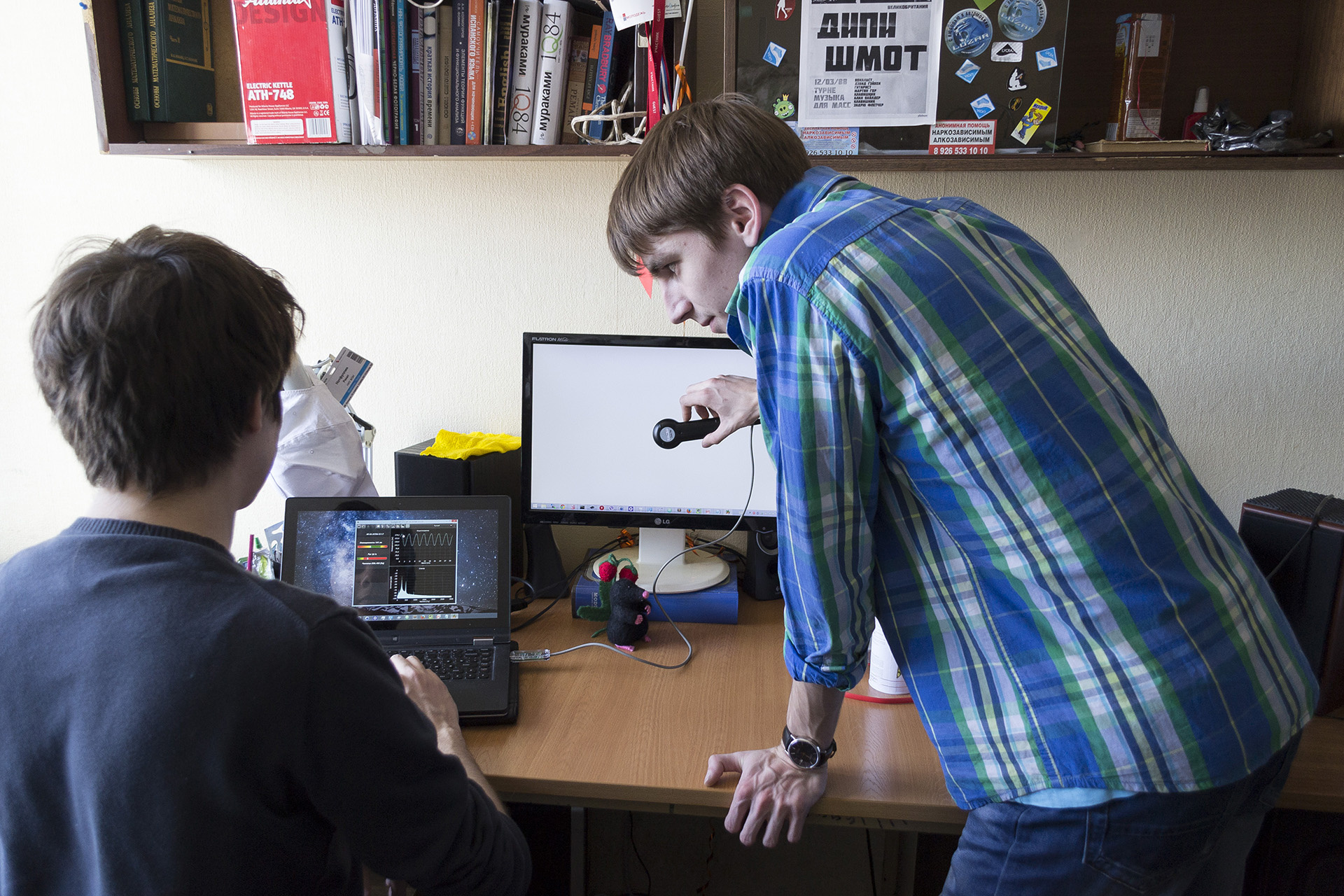
We will understand how and what the pulsation of the brightness of the observed scenes affects, and how the light sources and screens actually pulsate.
The mechanism of the effect of brightness pulsations on human health
An encephalogram of a person with a characteristic peak at the frequency of pulsating illumination has been published since the 1960s as evidence of the harmful effect of illumination pulsations on the nervous system.
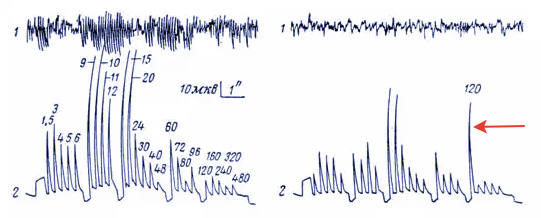
On the left - the control EEG, on the right - with a peak at a frequency of 120 Hz when the lighting is switched on, pulsing with a frequency of 120 Hz.
Today, according to neurophysiologists, imposing a high-frequency additional rhythm on the nervous system cannot be damaged. The picture only shows the susceptibility of the nervous system to the pulsations of illumination. The peak with the frequency of change of a significant environmental parameter comes up on the EEG - well done, healthy!
However, during prolonged intense visual work, the expressed pulsations of illumination are really harmful, since they interfere with the movement of the eye.
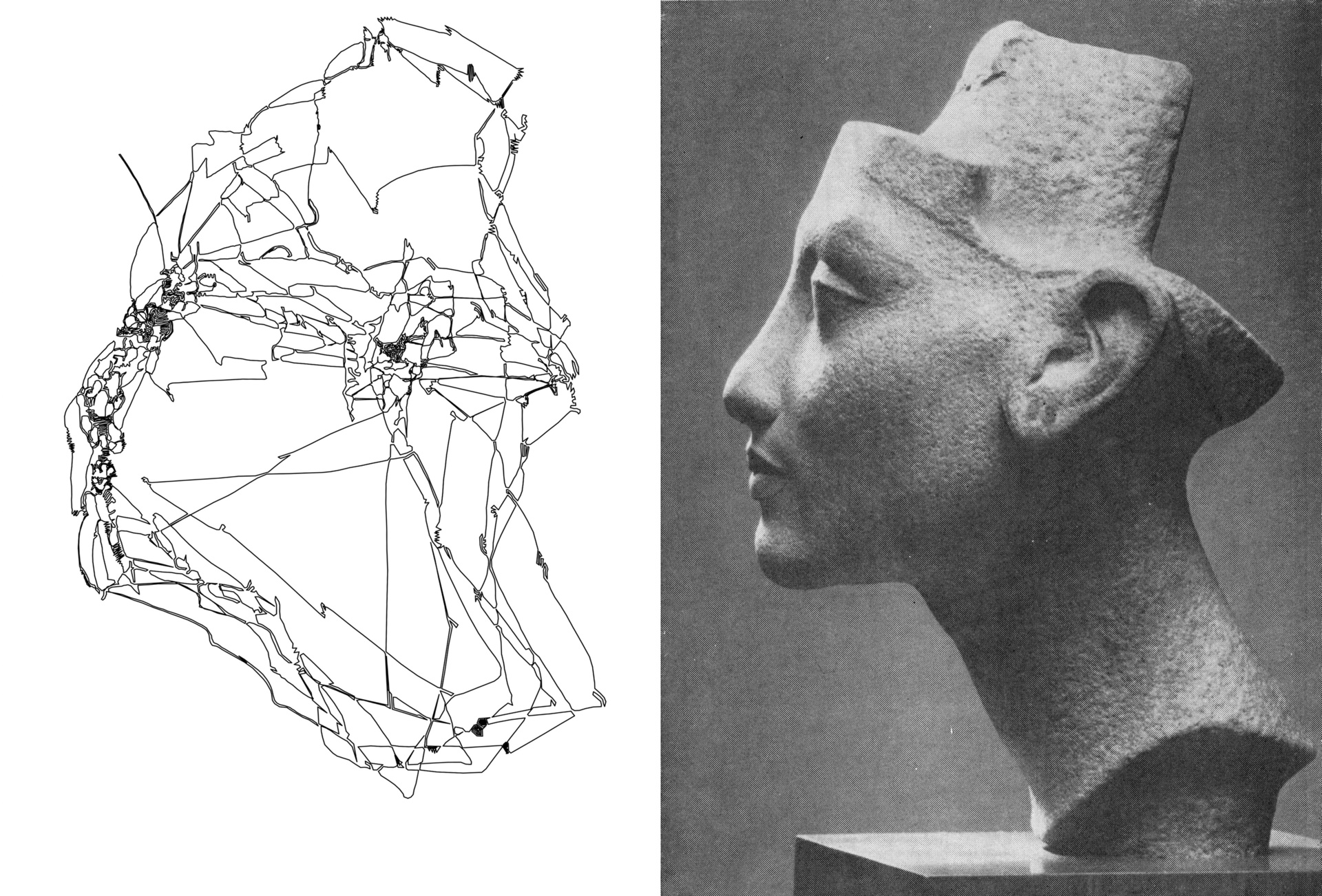
The frozen look is blind, to see, you need to move the look. The movement of the look on the face of one of the most beautiful women in history, Alfred Yarbus, 1965.
The gaze of a person moves in leaps and bounds - the saccadas. Pulsations at frequencies of 100 Hz and more are not perceived by consciousness, but the dips in the light in a short moment of jumping interfere with the view to “catch hold of” a new point.
The same effect appears when a subject moves fast (pencil test), shifts the camera, and quickly moves the eye: the observer sees an intermittent trace of the phantoms of the illuminated objects. This makes it difficult to move the gaze to the intended target, the saccades become more frequent and chaotic.

The appearance of phantoms of moving objects with pulsating lighting.
The most comprehensive and reliable generalization of modern data on the effect of lighting ripples on human health is the document " IEEE Recommended Practices for Mitigating Health Risks to Viewers ". Studies referenced by the document show the following:
The most optimistic estimate of the upper limit of pulsation effects in terms of frequency is based on the fact that the characteristic time of development of the action potential of a human nerve fiber is 5 ms, which corresponds to a bandwidth of 200 Hz. Domestic GOST prescribes not to take into account pulsations or harmonics of complex pulsations at a frequency of more than 300 Hz. However, in practice, a complex system of a large number of interacting neurons responds to frequencies up to kilohertz.
IEEE introduces the following criteria for risk levels:
What about ripple brightness says law
Domestic standards normalize “just pulsations” at frequencies up to 300 Hz, and rightly so, as it is unrealistic to make millions of people take into account the spectral features of pulsating lighting, it would be good to take into account at least one digit.
But one digit still did not work out, sanitary standards from the times of the USSR regulate the level of pulsations in different situations no higher than 20%, 15%, 10% and 5%. And over time, the number of normative documents, indicating in what cases what pulsations are permissible, only becomes larger.
But in non-state standards it is possible and necessary to use simplified norms. It is enough to accept that in places where people stay permanently, pulsations of no more than 3% are permissible . This is justified, and obviously meets all sanitary standards, and in most cases is carried out automatically.
Five years ago, it was extremely difficult to achieve brightness pulsations, for example, a LED lamp, less than 15%. And today there are instances with pulsations of tens of percent, especially often among small lamps (such as G9, etc.) due to the difficulties of placing a full-featured driver in such a small volume and even for small money. But for a typical modern conscientiously made LED lamp, the pulsation of illumination at the level of 1-2% is the norm. And an excellent rate!
But do not be a perfectionist. To demand a ripple level of 0.5% or less today is to run up at an inflated price, and sometimes even deception. It is unreasonably expensive to produce something perfect, any developer will confirm this. The buyer does not communicate with the developer, but with the manager, whose job is to promise “- yes, of course, we have exactly what you need.”
Real values of brightness pulsations
In 2015, I am acting. The chief editor of the magazine "Lighting" supervised the study of the actual parameters of lighting devices market. In particular, I gave to LampTest.ru 5 pieces of light bulbs inspected in an accredited laboratory, and making sure that the AlexeyNadezhin measurement results coincide with ours, we included in the statistics data on more than four hundred light bulbs from his project.
And with the students of the Department of Light Engineering at MEI, they measured the spectrum and depth of pulsations of 111 different models of monitors found in the rooms of the MEI dormitory. In the work, the registered in the register of measuring instruments and the verified luxmeter-yarkomer-pulsmetr "elight02" .
And that revealed:
A typical level of pulsations of street sodium lamps is about 30%. A typical level of pulsation of luminaires with 4 × 18 fluorescent tubular lamps with a “classic” EMPRA , standing in most institutions and educational institutions is more than 40%.
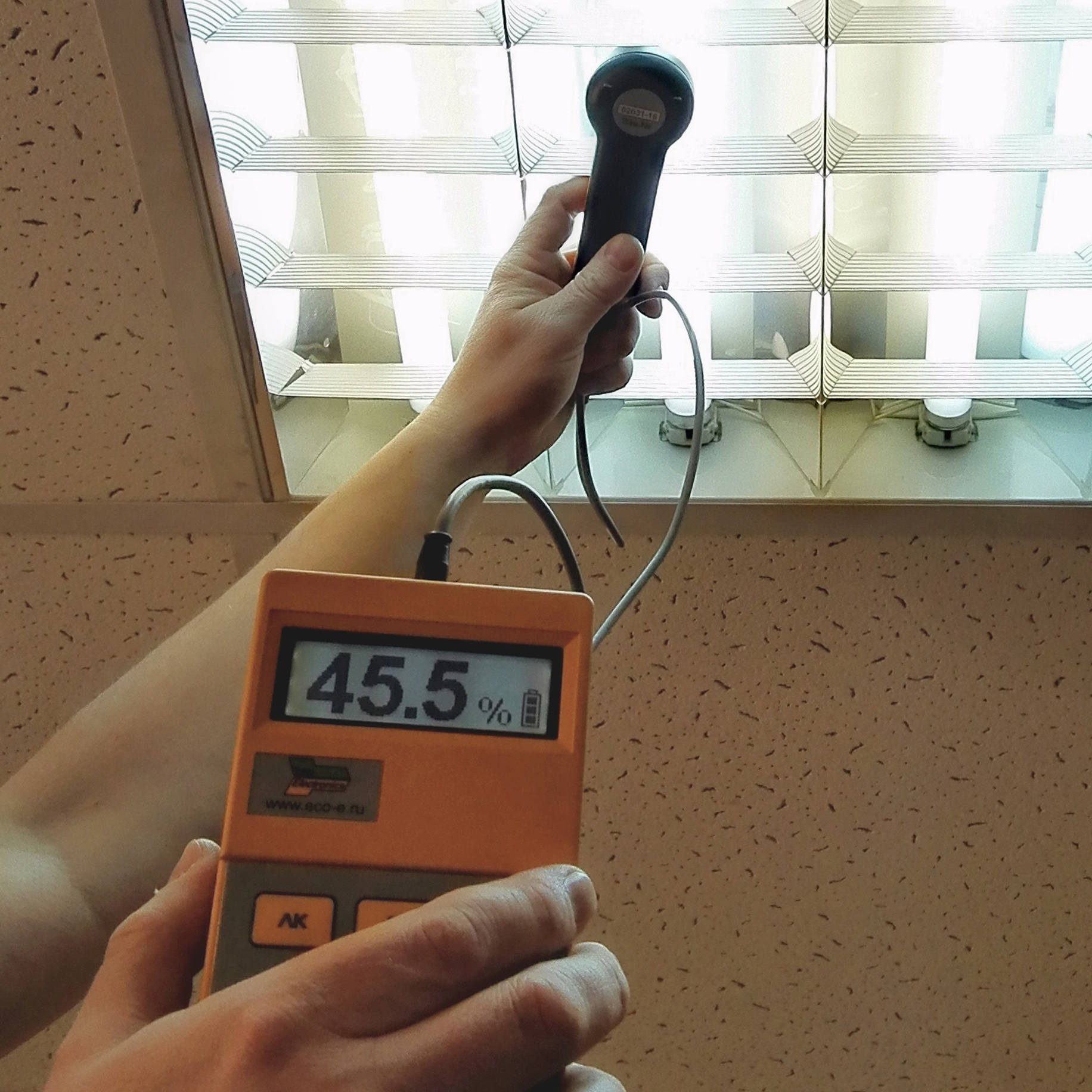
A typical fluorescent lamp pulsates at twice the frequency of a mains voltage of 100 Hz with a ripple depth of more than 40%.
Incandescent bulbs pulsate less fluorescent, but also be healthy. LampTest data is consistent with the data obtained by direct measurement in the Eco-E company's laboratory by its technical director Sergey Mamayev, where I brought a bag of various incandescent bulbs, bought in large chain stores, for measurements. As the power increases, the glow of the filament becomes more inertial, the ripple level drops, but still remains above an acceptable value.
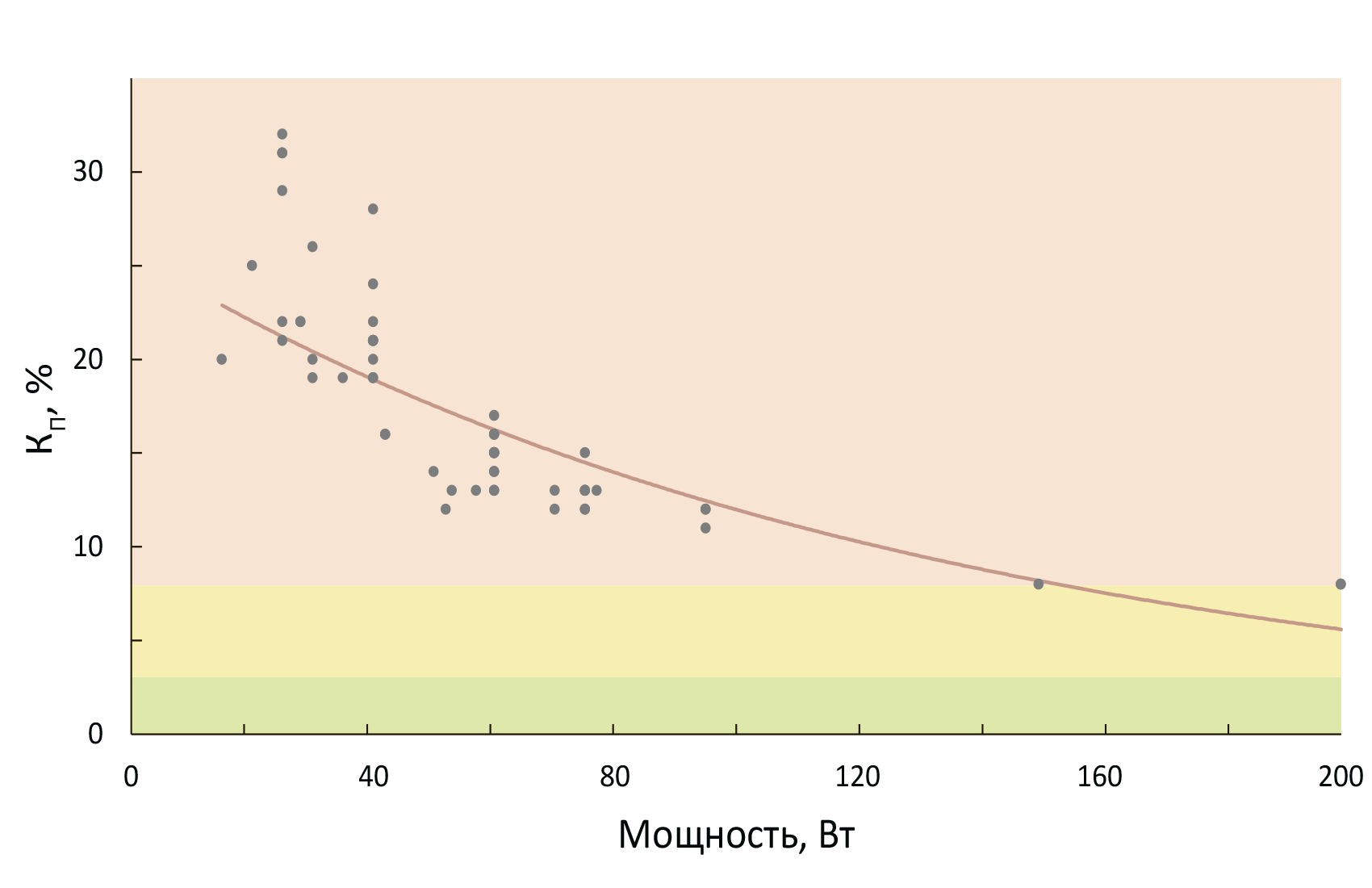
Pulsations of the luminous flux of incandescent lamps of different powers. Hereinafter, a deliberately safe level according to IEEE criteria is highlighted in green.
Compact fluorescent lamps (CFLs) pulsate at about half the size of incandescent lamps (6-10% versus 15-20%). LED lamps come in two varieties - most are very good, less pulsing as you please, up to 100% (horror-horror). LED lamps of all stripes are mostly good, low ripple.

The ripple coefficient of the studied CFLs (a), LED lamps (b) and office LED lamps, street and industrial LED lamps (g).
In 2016-2017, I combined the position of the head of the production lighting laboratory and measured a lot of fixtures from different manufacturers. Today, the ripple level of the LED lamp above 10% is surprising. Values up to 3% are actual rates.
And these changes occurred rapidly. Recently, the book copies of one of the best track lights for museum lighting - ERCO - fell into the hands. Efficiency of about 90 lm / W with CCT = 3000 K and Ra = 90 is the level for ERCO two or three years ago, but it is acceptable today. But what it is: I turn the goniometer with a lamp and see a whistle-dance on the screen, check the level of pulsations - more than 30%. The purebred Tridonic power supplies from these lamps will have to be thrown out and replaced with any modern ones with a pulsation of ~ 1%.
Well, the most interesting thing is the ripple brightness of the monitor screens . Domestic standards limit pulsation levels most severely in rooms with displays due to the following circumstance: if you illuminate the scene simultaneously with two sources pulsing at different frequencies, the nervous system is affected by both these frequencies and a whole bunch of their derivatives, including the low-frequency difference. Back in the USSR, they did not know how to deal with the ripple of the brightness of the monitors and habitually “turned the screws” on lighting technicians.
The ripple of the brightness of monitors and screens is caused by the PWM adjustment of the backlight, so the ripple is usually zero at 100% brightness and increases with decreasing brightness. For example, the monitor AOC i2769vm with maximum brightness, pulsations are absent, at 95% brightness pulsations are 8.5% ; at half brightness (see figure below) reach 100%; and when brightness is less than half, the ripple depth is still 100%, but darkness pauses appear between flashes of light .
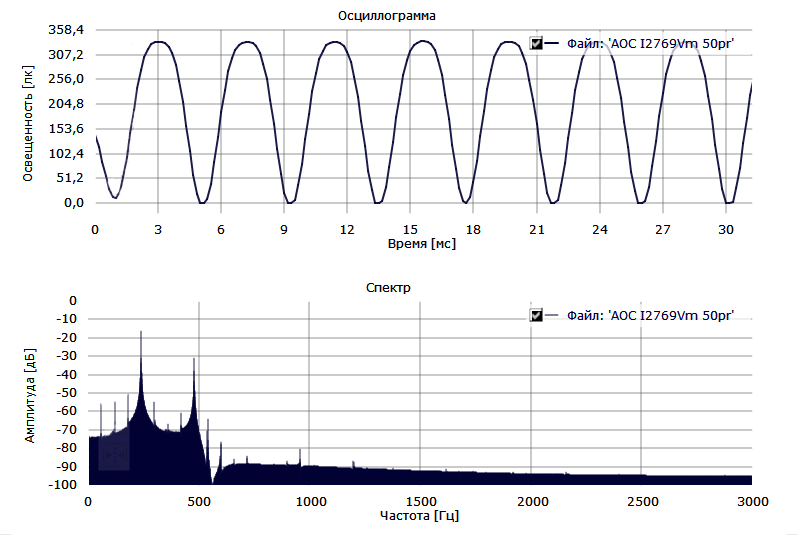
The nature of the ripple screen brightness AOC i2769vm. Here and below are screenshots of the Ecolight-AP program .
A typical example of the nature and range of the ripple screen of a smartphone on the example of the Samsung S7 Edge - as the brightness decreases, the pulsations increase from 5% to 69%, and the frequency of the main harmonic changes from 60 Hz to 241 Hz. Frequency variation is possible due to the design feature of self-luminous AMOLED screens. Note that the increase in frequency according to the IEEE criteria did not deduce the parameters of screen pulsations from the danger zone.

The shape (above) and the ripple spectrum (below) of the brightness of the Samsung S7 Edge screen at brightness levels of 100% and 50%.
Therefore, before measurements for statistics, the brightness of monitors and screens of smartphones was set at 50%. The results are catastrophic. In the green and even in the yellow zone got only a small proportion of copies. In some of the screens, the main harmonic is at a frequency of less than 70 Hz, which, according to IEEE, leads to pronounced ailments, headaches and even epileptic seizures.

The frequency and depth of the ripple screens of monitors, laptops and wearable electronics.
Is the ripple of the phone screen a disaster? No, but when reading, it is advisable to set the brightness at 100%, and in transport it’s not to look at the phone, but at the girls.

We will understand how and what the pulsation of the brightness of the observed scenes affects, and how the light sources and screens actually pulsate.
The mechanism of the effect of brightness pulsations on human health
An encephalogram of a person with a characteristic peak at the frequency of pulsating illumination has been published since the 1960s as evidence of the harmful effect of illumination pulsations on the nervous system.

On the left - the control EEG, on the right - with a peak at a frequency of 120 Hz when the lighting is switched on, pulsing with a frequency of 120 Hz.
Today, according to neurophysiologists, imposing a high-frequency additional rhythm on the nervous system cannot be damaged. The picture only shows the susceptibility of the nervous system to the pulsations of illumination. The peak with the frequency of change of a significant environmental parameter comes up on the EEG - well done, healthy!
However, during prolonged intense visual work, the expressed pulsations of illumination are really harmful, since they interfere with the movement of the eye.

The frozen look is blind, to see, you need to move the look. The movement of the look on the face of one of the most beautiful women in history, Alfred Yarbus, 1965.
The gaze of a person moves in leaps and bounds - the saccadas. Pulsations at frequencies of 100 Hz and more are not perceived by consciousness, but the dips in the light in a short moment of jumping interfere with the view to “catch hold of” a new point.
The same effect appears when a subject moves fast (pencil test), shifts the camera, and quickly moves the eye: the observer sees an intermittent trace of the phantoms of the illuminated objects. This makes it difficult to move the gaze to the intended target, the saccades become more frequent and chaotic.

The appearance of phantoms of moving objects with pulsating lighting.
The most comprehensive and reliable generalization of modern data on the effect of lighting ripples on human health is the document " IEEE Recommended Practices for Mitigating Health Risks to Viewers ". Studies referenced by the document show the following:
- High-frequency pulsations of illumination cause increased fatigue, reduced performance of visual work, eye fatigue, headaches and anxiety.
- With increasing pulsation depth, the severity of negative impact increases.
- With increasing frequency, the risks of negative impact are reduced.
The most optimistic estimate of the upper limit of pulsation effects in terms of frequency is based on the fact that the characteristic time of development of the action potential of a human nerve fiber is 5 ms, which corresponds to a bandwidth of 200 Hz. Domestic GOST prescribes not to take into account pulsations or harmonics of complex pulsations at a frequency of more than 300 Hz. However, in practice, a complex system of a large number of interacting neurons responds to frequencies up to kilohertz.
IEEE introduces the following criteria for risk levels:
- a low level of risk at frequencies less than f = 90 Hz corresponds to the level of pulsations, in percent not exceeding 0.025⋅f; more than 90 Hz - not exceeding 0,08⋅f. At frequencies above 1250 Hz, there are no restrictions on the level of pulsations. For the current frequency of 100 Hz, the pulsation levels corresponding to a low risk level are not higher than 8%.
- the safe level of the depth of pulsations at which there is no statistically detectable impact is 0.01⋅f for frequencies below 90 Hz and 0.0333⋅f for frequencies above 90 Hz. For a frequency of 100 Hz, the deliberately safe level of pulsations is no higher than 3%.
What about ripple brightness says law
Domestic standards normalize “just pulsations” at frequencies up to 300 Hz, and rightly so, as it is unrealistic to make millions of people take into account the spectral features of pulsating lighting, it would be good to take into account at least one digit.
But one digit still did not work out, sanitary standards from the times of the USSR regulate the level of pulsations in different situations no higher than 20%, 15%, 10% and 5%. And over time, the number of normative documents, indicating in what cases what pulsations are permissible, only becomes larger.
But in non-state standards it is possible and necessary to use simplified norms. It is enough to accept that in places where people stay permanently, pulsations of no more than 3% are permissible . This is justified, and obviously meets all sanitary standards, and in most cases is carried out automatically.
Five years ago, it was extremely difficult to achieve brightness pulsations, for example, a LED lamp, less than 15%. And today there are instances with pulsations of tens of percent, especially often among small lamps (such as G9, etc.) due to the difficulties of placing a full-featured driver in such a small volume and even for small money. But for a typical modern conscientiously made LED lamp, the pulsation of illumination at the level of 1-2% is the norm. And an excellent rate!
But do not be a perfectionist. To demand a ripple level of 0.5% or less today is to run up at an inflated price, and sometimes even deception. It is unreasonably expensive to produce something perfect, any developer will confirm this. The buyer does not communicate with the developer, but with the manager, whose job is to promise “- yes, of course, we have exactly what you need.”
Real values of brightness pulsations
In 2015, I am acting. The chief editor of the magazine "Lighting" supervised the study of the actual parameters of lighting devices market. In particular, I gave to LampTest.ru 5 pieces of light bulbs inspected in an accredited laboratory, and making sure that the AlexeyNadezhin measurement results coincide with ours, we included in the statistics data on more than four hundred light bulbs from his project.
And with the students of the Department of Light Engineering at MEI, they measured the spectrum and depth of pulsations of 111 different models of monitors found in the rooms of the MEI dormitory. In the work, the registered in the register of measuring instruments and the verified luxmeter-yarkomer-pulsmetr "elight02" .
And that revealed:
A typical level of pulsations of street sodium lamps is about 30%. A typical level of pulsation of luminaires with 4 × 18 fluorescent tubular lamps with a “classic” EMPRA , standing in most institutions and educational institutions is more than 40%.

A typical fluorescent lamp pulsates at twice the frequency of a mains voltage of 100 Hz with a ripple depth of more than 40%.
Incandescent bulbs pulsate less fluorescent, but also be healthy. LampTest data is consistent with the data obtained by direct measurement in the Eco-E company's laboratory by its technical director Sergey Mamayev, where I brought a bag of various incandescent bulbs, bought in large chain stores, for measurements. As the power increases, the glow of the filament becomes more inertial, the ripple level drops, but still remains above an acceptable value.

Pulsations of the luminous flux of incandescent lamps of different powers. Hereinafter, a deliberately safe level according to IEEE criteria is highlighted in green.
Compact fluorescent lamps (CFLs) pulsate at about half the size of incandescent lamps (6-10% versus 15-20%). LED lamps come in two varieties - most are very good, less pulsing as you please, up to 100% (horror-horror). LED lamps of all stripes are mostly good, low ripple.

The ripple coefficient of the studied CFLs (a), LED lamps (b) and office LED lamps, street and industrial LED lamps (g).
In 2016-2017, I combined the position of the head of the production lighting laboratory and measured a lot of fixtures from different manufacturers. Today, the ripple level of the LED lamp above 10% is surprising. Values up to 3% are actual rates.
And these changes occurred rapidly. Recently, the book copies of one of the best track lights for museum lighting - ERCO - fell into the hands. Efficiency of about 90 lm / W with CCT = 3000 K and Ra = 90 is the level for ERCO two or three years ago, but it is acceptable today. But what it is: I turn the goniometer with a lamp and see a whistle-dance on the screen, check the level of pulsations - more than 30%. The purebred Tridonic power supplies from these lamps will have to be thrown out and replaced with any modern ones with a pulsation of ~ 1%.
Well, the most interesting thing is the ripple brightness of the monitor screens . Domestic standards limit pulsation levels most severely in rooms with displays due to the following circumstance: if you illuminate the scene simultaneously with two sources pulsing at different frequencies, the nervous system is affected by both these frequencies and a whole bunch of their derivatives, including the low-frequency difference. Back in the USSR, they did not know how to deal with the ripple of the brightness of the monitors and habitually “turned the screws” on lighting technicians.
The ripple of the brightness of monitors and screens is caused by the PWM adjustment of the backlight, so the ripple is usually zero at 100% brightness and increases with decreasing brightness. For example, the monitor AOC i2769vm with maximum brightness, pulsations are absent, at 95% brightness pulsations are 8.5% ; at half brightness (see figure below) reach 100%; and when brightness is less than half, the ripple depth is still 100%, but darkness pauses appear between flashes of light .

The nature of the ripple screen brightness AOC i2769vm. Here and below are screenshots of the Ecolight-AP program .
A typical example of the nature and range of the ripple screen of a smartphone on the example of the Samsung S7 Edge - as the brightness decreases, the pulsations increase from 5% to 69%, and the frequency of the main harmonic changes from 60 Hz to 241 Hz. Frequency variation is possible due to the design feature of self-luminous AMOLED screens. Note that the increase in frequency according to the IEEE criteria did not deduce the parameters of screen pulsations from the danger zone.

The shape (above) and the ripple spectrum (below) of the brightness of the Samsung S7 Edge screen at brightness levels of 100% and 50%.
Therefore, before measurements for statistics, the brightness of monitors and screens of smartphones was set at 50%. The results are catastrophic. In the green and even in the yellow zone got only a small proportion of copies. In some of the screens, the main harmonic is at a frequency of less than 70 Hz, which, according to IEEE, leads to pronounced ailments, headaches and even epileptic seizures.

The frequency and depth of the ripple screens of monitors, laptops and wearable electronics.
Is the ripple of the phone screen a disaster? No, but when reading, it is advisable to set the brightness at 100%, and in transport it’s not to look at the phone, but at the girls.
Note 1: The post is a popular statement of the results published in the Optical Journal in Russian and in OSA publishing in English .
Note 2: If you are in Moscow, and have access to a large amount of included monitors and telephones (showroom of an electronics store?), I suggest you try on all your devices.
All Articles